***
Title: Oíza
Author: Javier Vellés
Editorial: Puente Editores. Printed in Spain, 2018. ISBN: 978-84-945274-7-0
Language: Spanish
375 pages
***
“In the most rugged area of the Colonya valley, on the south-facing slope, Ses Rotes is found, a little house that I bought from a couple of very handsome young hippies, “said Oíza. The house is like a Seat 600, the minimal expression of the country house, equivalent to the cottage that he tried to build in Oropesa de Toledo and was not able to. He described it this way: “It is a small shelter of barely 25 m2 per floor, which corresponds to the type of vernacular Andalusian architecture of two storeys. A minimum house built with stones, mud and trunks of trees for lintels and beams. The domestic layout does not exist, there is no design, there are environmental conditions that offer comfort in winter and summer: the southwest orientation of the main façade, walls with sufficient thickness and inertia, small windows arranged with common sense and shed roofing. A house whose mission is to give shelter to the family. For that reason there is no ostentation or desire to show off, it is a human refuge against the adversities of the environment. His daughter Marisa, who is tall, said “I hit my head with the ceiling”
“En la zona más agreste del valle de Colonya, en la ladera orientada al sur, se encuentra Ses Rotes, “una casita que compré a una pareja de jóvenes hippies muy guapos”, decía Oíza. La casita es como un Seat 600, la mínima expresión de la casa de campo, equivalente a la cabaña que quiso hacer en Oropesa de Toledo y no pudo. La describió así: “Se trata de un pequeño cobijo de apenas 25 m2 por planta, que corresponde con el tipo de arquitectura popular andalusí de dos plantas. Una vivienda mínima construida con piedras, tierra y troncos de árboles para dinteles y vigas. La distribución no existe, no existe el diseño, existen unas necesidades de implantación que ofrecen confort en invierno y en verano: la orientación suroeste de la fachada principal, unos muros con suficiente resistencia e inercia, unos huecos pequeños y dispuestos lógicamente y una cubierta de teja a una agua. Una vivienda cuya misión es dar cobijo a la familia. Por ese motivo no hay ostentación ni ganas de aparentar, se trata de un refugio humano ante las adversidades del medio”. Decía su hija Marisa, que es alta, “Me doy con la cabeza en el techo”
Javier Vellés, page 260
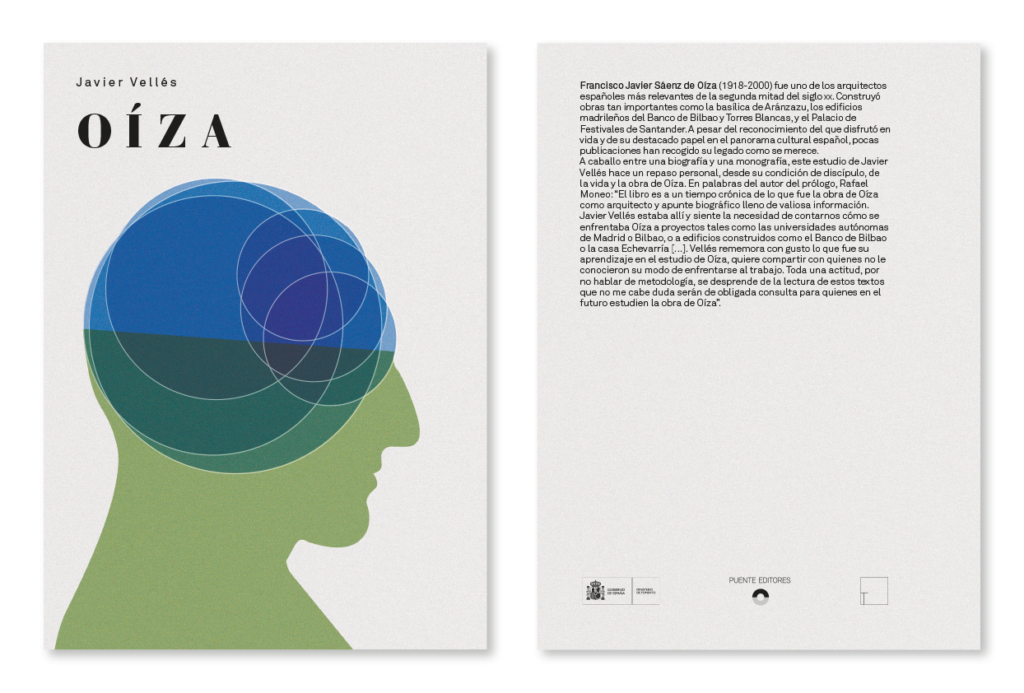
Doubt.
Dudar.
We are told at the beginning of this book that Francisco Javier Sáenz de Oíza is one of the stars of Spanish architecture. Master in pragmatism and the intelligence of need; master in a deep and emotional expressionism; master in a modernity dressed up in solemnity and elegant steel, master in a voluptuous and hedonistic organicism; master in postmodern irony. Closed drawers, labels that constitute both the main mistake and hindrance at the time of approaching to the work that Sáenz de Oíza bequeathed us.
Se nos dice al inicio del presente libro que Francisco Javier Sáenz de Oíza es una de las figuras fundamentales de la arquitectura española. Maestro en el pragmatismo y en la inteligencia de la necesidad; maestro en un expresionismo trascendente y emocional; maestro en una modernidad vestida de acerosolemne y elegante, maestro en un organicismo voluptuoso y hedonista; maestro en la ironía postmoderna. Cajones cerrados,etiquetas que constituyen además el principal error y lastre a la hora de acercarse a la obra que Sáenz de Oíza nos legó.
Oíza produced, of course, masterpieces materialized in different moments of the 20th century that have a stylistic correspondence with trends or movements converted into categories that pretend to organize, badly, the human manifestation that is the architectural practice. What makes Oíza a well considerd architect is not the mastery using different languages that crystallize in his work as witnesses to the cultural evolution of the 20th century, not even the enormous brilliance of any of his buildings. Oíza’s fundamental lesson as an architect, as a person, is the affirmation (perhaps it was the only thing he dared to affirm in his life) that there is only one architecture, the anonymous architecture. Although this seems to contradict hisdeep individualistic character, it is necessary to observe and understand his work in this way, as a single collective event that evolves through time without ever losing common structures. As a will to build a place for humankind in the world. As a critical practice away from of fundamentalist dogmatisms. Because he knew, and therefore transmited us, that architecture, when it is actually, presents common patterns that are repeated again and again regardless of place or time in which it materializes.
Oíza produjo desde luego obras maestras materializadas en diferentes momentos del siglo XX que tienen una correspondencia estilística con las coyunturas, corrientes o movimientos convertidos en categorías que pretenden organizar, mal, la manifestación humana que es la práctica arquitectónica. Lo que convierte a Oíza en un verdadero maestro no es el dominio de diferentes lenguajes que cristalizan en su obra como testigos del devenir cultural del siglo XX, ni siquiera la enorme brillantez de alguno de sus edificios. La lección fundamental de Oíza como arquitecto, como persona, es la afirmación (quizá fue lo único que se atrevió a afirmar) de que arquitectura sólo hay una, la arquitectura anónima. Aunque esto parezca entrar en contradicción con el exacerbado carácter individualista del personaje, es necesario observar y entender su obra así, como un solo acontecimiento colectivo que evoluciona con el tiempo sin perder nunca unas estructuras comunes. Como un deseo de construir en el mundo un lugar para el hombre. Como una práctica crítica alejada y enemiga de dogmatismos fundamentalistas. Porque él sabía, y así nos transmite, que la arquitectura, cuando es, presenta unos patrones comunes que se repiten una y otra vez independientemente de lugar o época en que se materialice.
It will not matter, or so should happen, that Saénz de Oíza’s worksare accessed by descending between shadows to a rock and concrete cave or climbing through the open sky between red columns with classicist and pop appereance.
Poco importará, o así debería suceder, que en la obra de Saénz de Oíza se acceda descendiendo entre sombras a una gruta de roca y hormigón o se haga ascendiendo a cielo abierto entre columnas rojas de apariencia a la vez clasicista y pop.
When someone points to the moon, the fool looks at the finger.
Cuando alguien señala a la luna, el necio mira el dedo.
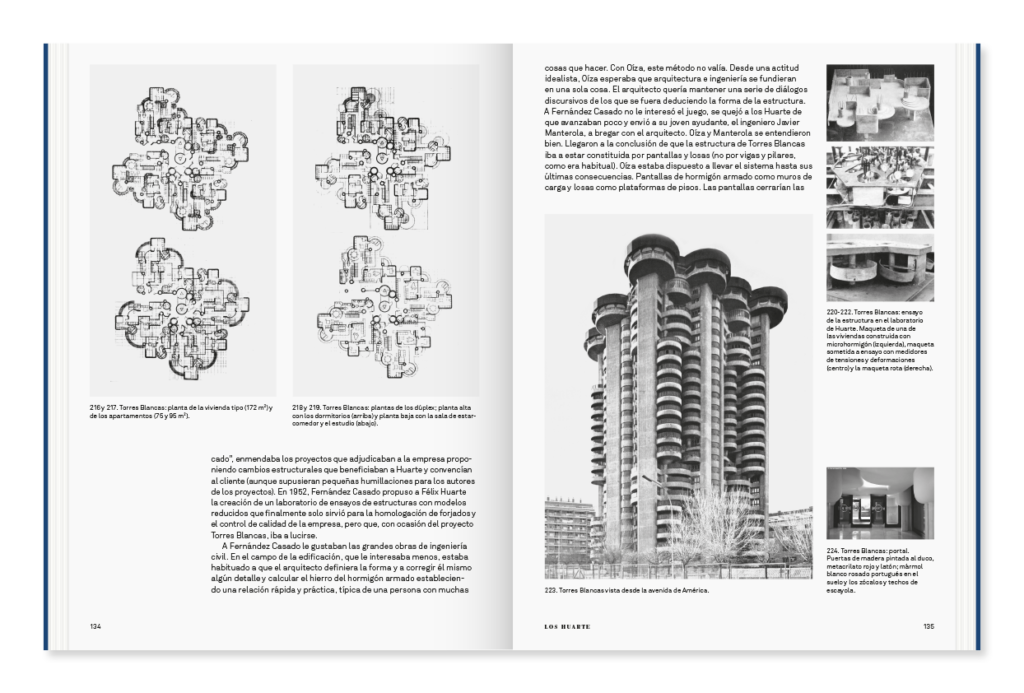
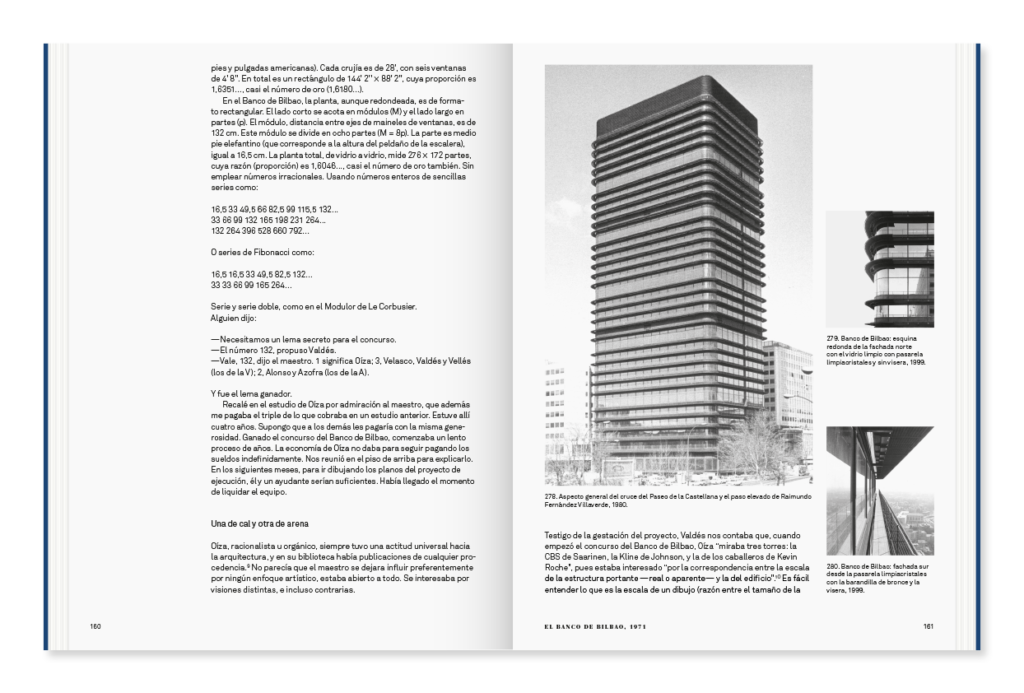
“At Oíza’s office one could worked comfortably. On the upper floor the large family lived under the care of María Felisa, and on the lower floor one could find the entrance hall, where there was a DKW motorcycle and a piano, the library and the Oiza’s office; we worked in the basement, which had a large room with tables for all of us and two rooms, one for the archives and one for a small workshop of materials, tools and machines to make models. Oíza named the woods he had – pine, beech, oak, boxwood, teak, raft, ocume, poplar, etc. – and talked about the properties of each of them. “Let’s see who is able,” he said, offering us a piece of oak, of driving in this wood without spoiling the nail “.
“En el estudio de Oíza se trabajaba bien. En el piso superior vivía la familia numerosa al cuidado de María Felisa, y en la planta inferior estaba el recibidor, donde había una motocicleta DKW y un piano, la biblioteca y el despacho del maestro; nosotros trabajábamos en el semisótano, que tenía una gran sala con mesas para todos y dos cuartos, uno para el archivo y uno para un pequeño taller de materiales, herramientas y máquinas para hacer maquetas. Oíza nombraba las maderas que tenía – pino, haya, roble, boj, teca, balsa, ocume, chopo, etc. – y hablaba de las propiedades de cada una de ellas. “A ver quién es capaz, decía ofreciéndonos un trozo de encina, de clavar en esta madera sin que se le tuerza la punta”.
In the morning we went to school; Oíza had his classes and we ours. In the afternoon we worked in the studio. We started at four thirty and each one entered with his own key (it was also the key to his house). In the middle of the afternoon, Pili, who was a beautiful maid, came downcarrying the big tray of coffee with milk and toast with butter. Oíza used to go down to have a snack with us and we exchanged impressions about the progress of the work. He also dropped by at any time, when he had made a discovery in his library, where he constantly studied, or when he came up with some idea that seemed interesting to him. “
Por la mañana íbamos a la escuela; Oíza tenía sus clases y nosotros las nuestras. Por la tarde trabajábamos en el estudio. Empezábamos a las cuatro y media y cada uno entraba con su propia llave (era también la llave de su casa). A media tarde bajaba Pili, una hermosa doncella portadora de la gran bandeja en la que había café con leche y pan tostado con mantequilla. Oíza solía bajar a merendar con nosotros e intercambiábamos impresiones sobre la marcha del trabajo. Aparecía también en cualquier momento, cuando había hecho algún hallazgo en su biblioteca, donde estudiaba constantemente, o cuando daba con alguna idea que le parecía interesante.”
Javier Vellés, page 115

Thirst.
La sed.
The work of Francisco Javier Saénz de Oíza swings between the remarkable exhibition that some of its most famous buildings enjoy and the veiled oblivion that covers most of its production. The almost absolute non-existence of any monograph at the height of its author exacerbates this situation. For many architects, especially the younger generations, Oíza is reduced to Torres Blancas and BBVA buildings, both in Madrid.
La obra de Francisco Javier Saénz de Oíza bascula entre la exposición notable de la que gozan algunos de sus edificios más conocidos y el velado olvido que cubre la mayoría de su producción. La inexistencia prácticamente absoluta de ninguna monografía a la altura de su autor agudiza esta situación. Para muchos arquitectos, especialmente de las generaciones más jóvenes, Oíza se reduce a Torres Blancas y el BBVA, ambos en Madrid.
We opened the book of Javier Vellés with great expectation. Big volume, more than appealing price. The edition soon reveals that this book is not a conventional monograph. With the meticulous elegance and asceticism that characterize the books published by Puente Editores, a narrative text of considerable length is dotted with numerous black and white illustrations. Images and words build a chronological discourse that comprises the whole life of the architect, exhaustively and close in some sections, in others with a surprising distance or detachment.
Abrimos así el libro de Javier Vellés con gran expectación. Tomo voluminoso, precio más que atractivo. La edición nos revela pronto que no se trata este libro de una monografía convencional. Con la cuidada elegancia y ascetismo que caracterizan los libros publicados por Puente Editores, se despliega un texto narrativo de extensión considerable salpicado por numerosas ilustraciones en blanco y negro. Imágenes y palabras construyen un relato cronológico que comprende la vida del arquitecto, de forma exhaustiva y cercana en algunos tramos, en otros con una distancia o desapego sorprendente.
We can not deny it, a certain disappointment invades us while we read the book. We had doubts at first, but as we move forward we undoubtedly have a certainty: this is not the monograph about Oiza’s work that we all hope for. Halfway between a biography and a critical essay, we find in its considerable extension a relatively complex interweaving of anecdotes and personal stories, testimonies of some of the most relevant figures of the Spanish architectural scene of the second half of the 20th century, short textsproviding historical and social context to the work of Saénz de Oíza, critical analyzes of some of Oízas’ works, perhaps too light chronicles of most of them … This amalgam of different registers supposes, from our pint of view, the main virtue and defect of the text of Javier Vellés. It is not a monographic work where you can know in depth the projects of Saénz de Oíza, although it is necessary to point out that the large number of illustrations that accompany the text do allow to understand the most of them. It is not a critical text that seeks to interpret or explain the work of Saénz de Oíza, nor does it pursue the goal of constructing a frame of reference for it, but it is necessary to point out that the chronicles of the different projects, whether picking up words from others or , in most cases, through the criteria and personal experience of Javier Vellés, it offers us some tools to undertake this task. We can not consider it simply a journalistic chronicle about the work of Saénz de Oíza or a biographical account of his life, although it is fair to admit that, with greater or lesser fortune according to the moment, the narrative unfolded by the author allows us to stay closer to a complex person that we were looking forward to knowing.
No lo podemos negar, cierta decepción nos invade al adentrarnos en el libro. Tuvimos dudas al principio, pero a medida que avanzamos albergamos desde luego una certeza: ésta no es la monografía de Oíza que todos esperamos. A medio camino entre una biografía costumbrista y un ensayo crítico, encontramos en su considerable extensión un entrelazamiento relativamente complejo de anécdotas y relatos personales, testimonios de algunas de las figuras más relevantes del panorama arquitéctonico español de la segunda mitad del siglo XX, pasajes que dan contexto histórico y social a la obra de Oíza, análisis críticos de algunas de las obras de Oízas, crónicas quizá demasiado ligeras de la mayoría de ellas… Esta amalgama de registros supone a la vez, según nuestro juicio, principal virtud y defecto del texto de Javier Vellés. No se trata de una obra monográfica donde conocer en profundidad los proyectos de Saénz de Oíza, aunque es necesario señalar que la gran cantidad de ilustraciones que acompañan al texto sí permiten conocer de forma más o menos completa la mayoría de ellos. No es un texto crítico que persiga interpretar o explicar la obra de Saénz de Oíza, ni tampoco persigue el objetivo de construir un marco referencial para la misma, pero es necesario apuntar que las crónicas de los distintos proyectos, ya sea recogiendo palabras de otros o, en la mayoría de los casos, mediante el juicio y la experiencia personal de Javier Vellés, nos ofrecen algunas herramientas para poder emprender esa tarea. No la podemos considerar simplemente una crónica periodística sobre la obra de Saénz de Oíza o un relato biográfico sobre su vida, aunque es justo admitir que, con mayor o menor fortuna según el momento, la narración que el autor desarrolla nos permite acercarnos a un personaje complejo que anhelábamos conocer.
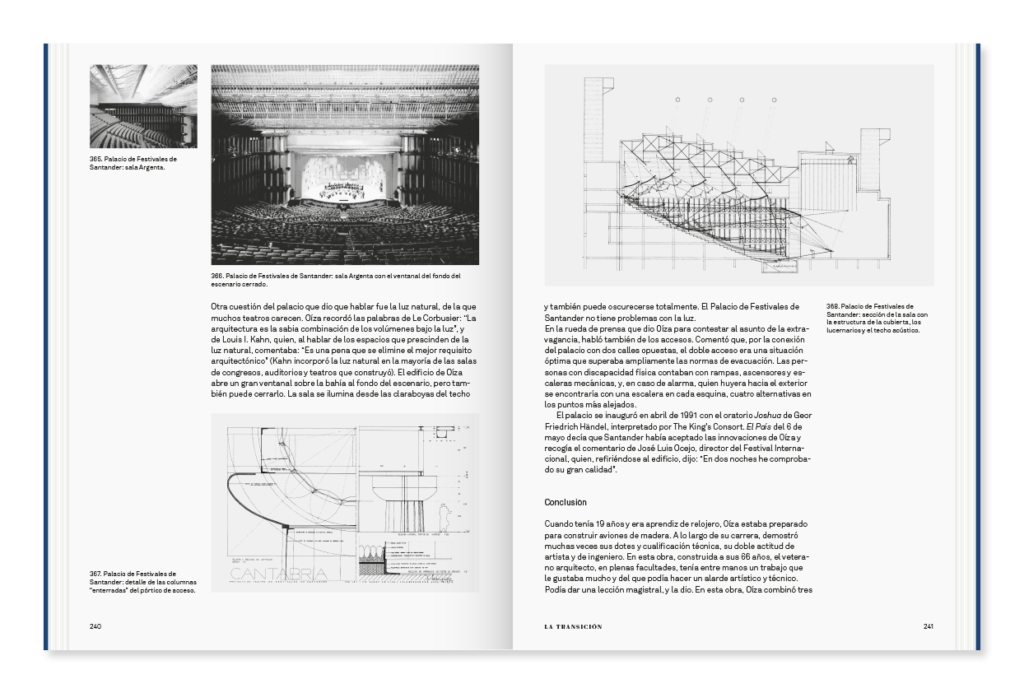
“From the plane we saw the snowed Parnassus, we arrived at sunset and we stayed in the Gnomonia square. Without the students, who would be accommodating themselves in their lodgings, we crossed the neighborhood of Plaka and climbed towards the Acropolis. In the middle of the slope we deviate to climb the rock of the Areopagus. From the summit, above the tops of the pines, we saw the great wall and the Propylaea. When we arrived at the archaeological gates it was twilight time; we wanted to see the Parthenon, but the guard did not let us through. Oíza spoke to him in Spanish, in English and spoke also some words in Greek. He explained that we were architects and teachers. The guard refused. Raising his voice, facing him with an angry gesture, he said that he was Saenz de Oiza, 66 years old, a professor at the School of Architecture in Madrid, who had waited a long time and traveled many kilometers to get there and that he did not accept a no as an answer. The guard, who would not understand the words but for sure he did the gesture, put his hand on the holster of the gun. “
“Desde el avión vimos las nieves del Parnaso, llegamos al atardecer y nos hospedamos en la plaza Gnomonia. Sin los alumnos, que estarían acomodándose en sus alojamientos, cruzamos andando el barrio de Plaka y subimos hacia la Acrópolis. En la mitad de la cuesta nos desviamos para trepar a la roca del Areópago. Desde el vértice, por encima de las copas de los pinos, vimos el gran muro y los Propileos. Cuando llegamos a las cancelas arqueológicas era la hora del crepúsculo; queríamos ver el Partenón, pero el guarda no nos dejó pasar. Oíza le habló en español, en inglés y pronunció alguna palabra en griego. Le explicó que éramos arquitectos y profesores. El guarda se negó. Alzando la voz, mirándole de frente con ademán airado, dijo que él era Saénz de Oíza, de 66 años, Catedrático de las Escuela de Arquitectura de Madrid, que había tenido que esperar mucho y recorrer muchos kilómetros para llegar hasta allí y que no iba a conformarse con un no. El guarda, que no entendería las palabras pero si el gesto, puso la mano sobre la funda de la pistola.”
Javier Vellés, page 250
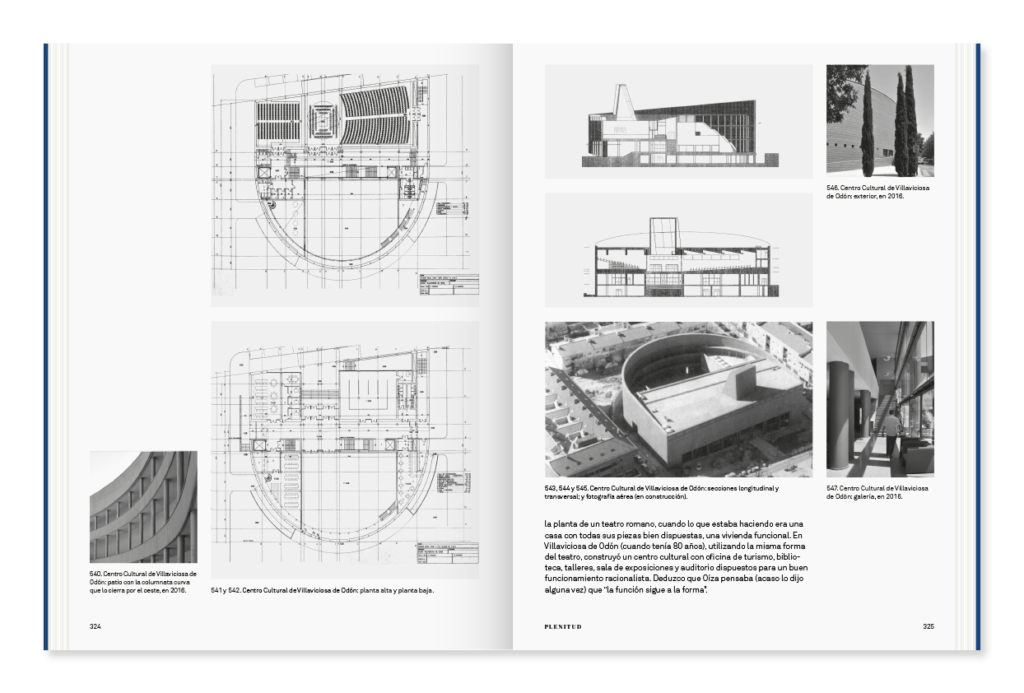
Share.
Compartir.
This is not the book we would have wanted about Saénz de Oíza. Perhaps waiting for that one, we have found, nevertheless, the book we needed. We will wait for the opportunity to deepen the work of Saénz de Oíza with all the necessary documentation. We receive now, with great pleasure, the invitation of Javier Vellés to walk with him on this trip to the interior of Saénz de Oíza. His words, his memories, the images he shares so gently with us lead us to the end of a path that is nothing but circular, placing us, again and again, in the starting point. As Oiza always did, opening the way with doubt as the only companion.
No es este el libro que nosotros habríamos querido sobre Saénz de Oíza. Quizá esperando aquél, hayamos encontrado, sin embargo, el libro que necesitábamos. Para otra ocasión dejamos la oportunidad de poder profundizar en la obra de Saénz de Oíza con toda la documentación necesaria. Aceptamos ahora, pues, con enorme gusto y placer la invitación de Javier Vellés a caminar junto a él en este viaje al interior de Saénz de Oíza. Sus palabras, sus recuerdos, las imágenes que comparte tan gentilmente con nosotros nos conducen hasta el final de una senda que no es sino circular, y que nos coloca, de nuevo, una y otra vez en la casilla de salida. Como siempre hiciera el maestro, abriendo camino con la duda como única compañera.

“My partner and I, because sometimes I have a partner, we both enjoy imagining ourselves as members of a new order, or better an old one: we are not knights, nor riders of any kind, but walkers, a category, I hope, even older and more honorable”
“Mi compañero y yo, porque a veces llevo un compañero, disfrutamos imaginándonos miembros de una orden nueva, o mejor antigua: no somos caballeros, ni jinetes de cualquier tipo, sino caminantes, una categoría, espero, aún más antigua y honorable”
Henry David Thoreau, Walking. 1862
